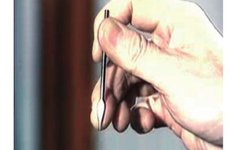1
Concept
The bloodletting therapy in Traditional Chinese Medicine (TCM), also known as “Jian Ci Fang Xue Li Fa” (Needle Bloodletting Therapy), involves using a three-edged needle, a thick needle, or a small scalpel to puncture or incise specific acupuncture points on the body to release a small amount of blood. This method aims to disperse internal heat and toxins to treat diseases.
2
Operational Methods
Three-Edged Needle
1. Point Puncture Method
Definition:
This method involves quickly inserting the three-edged needle into a specific superficial area of the body and then quickly withdrawing it.
Method:
Before point puncture, techniques such as pushing, rubbing, squeezing, and stroking can be applied to the area to promote local blood congestion. During the puncture, one hand stabilizes the puncture site while the other holds the needle, exposing the needle tip 3-5mm. The needle is quickly inserted and withdrawn, maintaining the needle body on the same axis. After puncturing, an appropriate amount of blood or fluid can be released, and additional pushing techniques can be used to increase the volume of blood or fluid released.

Applicable Areas:
This method is commonly used on the tips of fingers and toes at points such as Shixuan (十宣), Shierjing (十二井), and on the head and face at points like Cuanzhu (攒竹), Shangxing (上星), Taiyang (太阳), and Erjian (耳尖).
2. Blood Vessel Puncture Method
Definition:
This method involves using a three-edged needle to puncture specific blood vessels in the body to release an appropriate amount of blood.
Method:
Before puncturing the blood vessel, techniques such as pushing, rubbing, squeezing, and stroking can be applied to the area. For limbs, a tourniquet can be applied proximal to the puncture site to promote local blood congestion. During the puncture, one hand stabilizes the puncture site while the other holds the needle, exposing the needle tip 3-5mm. The needle is quickly inserted and withdrawn to release an appropriate amount of blood, after which the tourniquet is released.
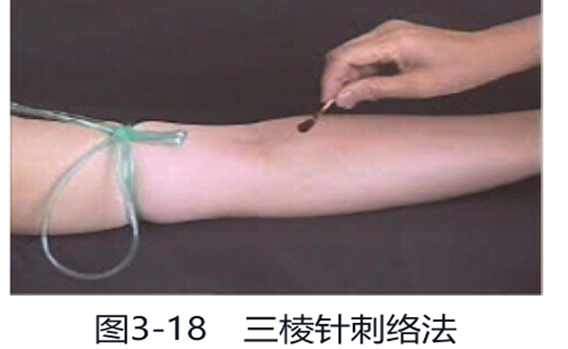
Applicable Areas:
This method is often used on small veins in the forehead, temples, ears, and back, with a single session releasing 5-10ml of blood. If used on veins in the elbow or popliteal fossa, it can release several tens of milliliters.
3. Scatter Puncture Method
Definition:
This method involves using a three-edged needle to perform multiple point punctures in a specific area of the body.
Method:
One hand stabilizes the puncture site while the other holds the needle, performing a circular scatter puncture around the affected area.
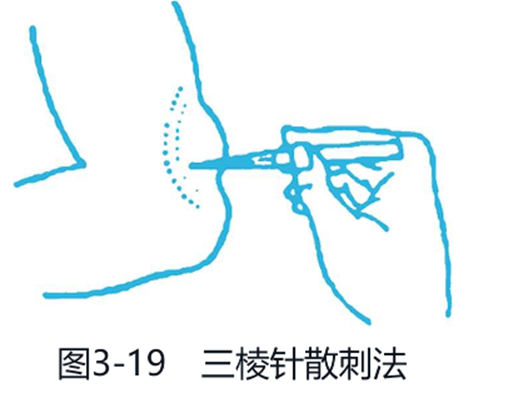
Applicable Areas:
Depending on the disease, there are two types of puncture methods: for stubborn skin conditions or initial stages of abscesses, puncturing around the area can release blood; for localized swelling after sprains or bruises, puncturing in a scatter pattern can release blood.
4. Lifting Puncture Method
Definition:
This method involves using a three-edged needle to puncture specific areas of the body, lifting the needle to break the skin or subcutaneous tissue.
Method:
One hand stabilizes the puncture site while the other holds the needle at an angle of 15°-30°, inserting it to a certain depth before lifting the needle tip to break the skin or subcutaneous tissue.
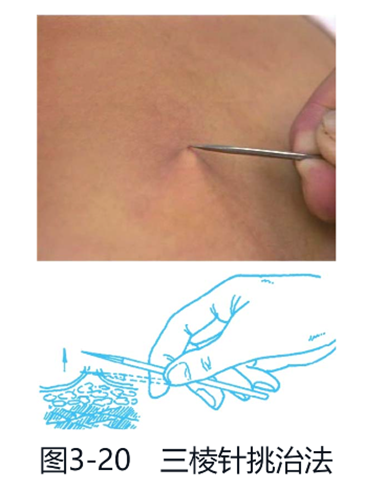
Applicable Areas:
This method is suitable for Back Shu Points and points of disease reaction.
Skin Needle
1. Needle Holding Method
(1) Soft Handle Skin Needle Place the end of the needle handle in the palm, with the thumb on top, the index finger below, and the remaining fingers in a fist position to stabilize the end of the needle handle.
(2) Hard Handle Skin Needle Hold the sides of the needle handle with the thumb and middle finger, placing the index finger above the middle section of the needle handle, while the ring and little fingers stabilize the end of the needle handle between the thenar and hypothenar eminences.

2. Tapping Method
Align the needle tip with the tapping area, using a heavier wrist force to tap rhythmically and evenly, up and down. If the needle body is raised during tapping, with a slower rhythm and greater force, and the needle tip contacts the skin for a longer time, local bleeding may occur, and the patient will experience significant pain. It is important to keep the needle tip perpendicular to the skin, ensuring accurate tapping and uniform strength. Avoid inserting the needle tip at an angle or dragging the needle backward.
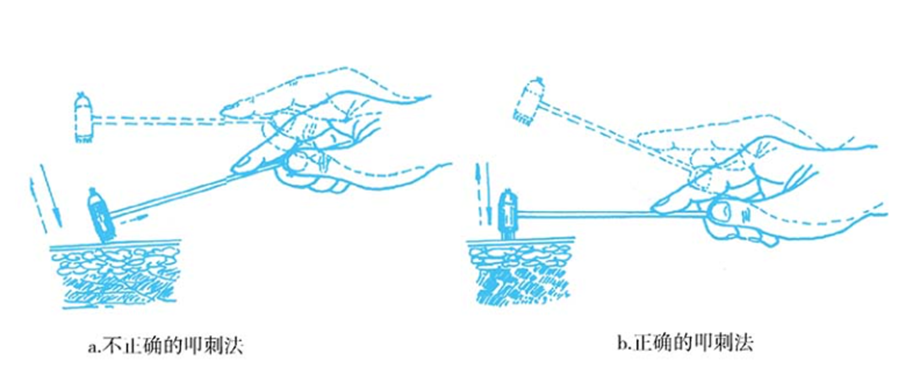
3. Tapping Areas
(1) Acupuncture Point Tapping Also known as point tapping, this involves selecting acupuncture points and reaction points related to the disease for tapping. The selection is based on the therapeutic effects of the acupuncture points, commonly used on Back Shu Points, Jiaji Points, certain specific points, and positive reaction points.
(2) Meridian Tapping Also known as linear tapping, this involves tapping along the meridian pathways related to the disease. It is mainly used on the Du Meridian and Bladder Meridian in the neck, back, waist, and sacral areas. The Du Meridian is known as the sea of Yang meridians, regulating the Yang energy of the body; the Back Shu Points of the five zang and six fu organs are distributed along the Bladder Meridian, thus having a wide treatment range. Additionally, the three Yin and three Yang meridians below the elbows and knees can treat corresponding organ and meridian disorders.
(3) Local Tapping This refers to tapping at the site of the lesion, which can be divided into patch tapping and circular tapping. Patch tapping is often used for local skin lesions such as sprains, stubborn skin conditions, and herpes zoster, while circular tapping is commonly used for joint diseases.

The above is the concept, preparation phase, and operation of bloodletting therapy. Please look forward to the next issue covering contraindications, indications, clinical applications, and precautions of bloodletting therapy.
Reference Books: “Folk Remedies in Traditional Chinese Medicine” Chief Editor: Chang Xiaorong
“Needle Bloodletting Therapy in Traditional Chinese Medicine” Author: Guo Yi
To be continued
Written by/Xin Cheng Jun
Reviewed by/Wang Yage
Typeset by/Yu Muhuai
Checked by/Zhao Yanrui
Supervised by/Lin Zhizhan
This article, except for the content indicated as sourced, is derived from publicly available online channels. If there are any copyright disputes, please contact us for removal.

